I’ve always lived in a small space. In fact, the “one acre” of One Acre Farm is lavish, compared to all my past homes. I grew up in a modest suburb, with a small vegetable garden in the backyard. Then came college dormitories, and, after marriage, a series of apartments. Our first house was on a postage stamp suburban lot, where we grew a few vegetables and herbs in a patio bed and some containers, right outside the kitchen door. I loved that little kitchen garden. It wasn’t much, but everything we grew was literally within arm’s reach of the kitchen.
Although one acre is big to me, it’s small to others, which explains why I am often asked for suggestions and resources on how to start a small farm. This post is my answer. A bit long winded, maybe, but that’s testimony to the fact that you can do a lot in a small space! First, some basic words of advice:
- Start small. After all, you only have a small space. But seriously, this is especially true if you contemplate raising animals. Get small ones, and just a few of them. If you’d have to keep them in cramped and crowded conditions, it would be better from an animal welfare stand point, to buy eggs, dairy products, and meat from a local farmer who can provide space enough for them express their natural behaviors.
- Produce what you like to eat or use. Radishes are easy to grow in a tiny garden, but why plant them if you don’t like them?
- Let your creativity soar, and scan lots of online images for ideas, especially on small space gardening. You’ll be amazed at what some people have done to make use of cramped quarters.
- Go for a diversity of products, rather than a large quantity of a few. This creates a healthier ecosystem, which is better for wildlife and helps prevent pest outbreaks. Read more on that concept in Permaculture Principles for Practical Gardeners and Farmers.
How to Start a Backyard Farm
This post contains links to online shopping, which is a way for you to support One Acre Farm at no additional cost to you. Click here for my full affiliate disclosure. Thanks for your support!
Vegetables
Container gardening is an excellent choice for a small-space farm. Many vegetables and herbs can thrive in containers, and some do well even indoors. How about microgreens indoors? You do need to water container gardens very frequently, however, because containers dry out quickly. Container grown trees also need protection in cold winter climates, because the roots are not insulated as well as those of trees growing in the ground.
Raised beds are a good idea for small space gardening, because the yield is better. In square foot gardening, a grid of 1-foot squares is placed on the bed to guide you in planting even more intensively
Vertical gardening is the new wave of urban agriculture. Check out some uber creative examples on my Vertical Gardening pinterest board here, and follow it if you’d like to see my updates.
Some vegetables that are usually associated with larger scale farming can produce well in a small space with a little extra planning and care. Even corn can succeed, if you understand its pollination requirements. Read my tips on growing corn in a small space here.
Vertical gardening within any farm also adds vertical habitat for the local wildlife, once again creating diversity which helps prevent pest outbreaks, as you can read in Permaculture Principles.
Fruits, berries, and nuts
Strawberries are a classic, for small-space gardening. I’m sure you’ve seen those tall strawberry jars in garden centers. Strawberries can thrive in them, with proper care.
Blueberries grow as shrubs, and some varieties are quite compact. Perfect for small-scale farming. With plenty of sunlight and careful attention to soil acidity, they can produce well in containers. We have blueberry plants scattered around the yard. With their bright red autumn leaves, they even have ornamental value.
Some fruit trees come in dwarf varieties that fit nicely in small backyards, or even in containers. Our 3 small apple trees produce more apples than I have time to preserve. Our pear trees are just getting started, but with some luck, they’ll eventually produce as well as our apples.
Grapes can be grown on an arbor, making excellent use of vertical space. And, they can be easily pruned to keep them from outgrowing their space. Our Concord and Niagara grapes make excellent juice.
Hazelnuts are one of the few nuts that grow as shrubs. However, some hazelnut varieties are trees, so be sure you know which you are getting. Ours grew quickly and produced abundantly just a few years after planting 2-3 foot tall plants.
Fiber
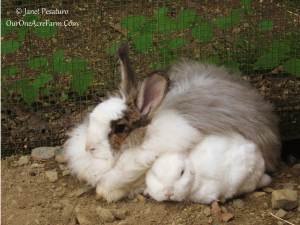
We had these 2 rabbits for years. I had the fur from the angora rabbit spun with sheep’s wool into a beautiful yarn.
Angora rabbits produce a silky soft fur that can be blended with wool for a luxuriously soft natural fiber. Rabbits don’t need a huge amount of space, but they do enjoy playing, exploring, and eating wild forage. While they are often touted as animals that do well in cages and hutches, it’s hard for me to imagine that they are happy under such conditions. We kept ours in a shed with an outdoor enclosure, and also let them free range in the chicken yard in the afternoon. They are active and curious when given the opportunity to explore.
Shetland sheep are a small breed with a beautiful fleece that’s a favorite for hand knitters and weavers. A small flock could be a good choice for small-scale homesteading, where livestock are permitted. They can also be used for meat and milk. To learn to start your own flock, read Raising Shetland Sheep.
Milk
Nigerian dwarf goats can be milked, and will also fit in a good sized backyard where livestock are permitted. You can make your own cheese and goat milk ice cream.
Honey
Bee keeping requires little time and little space, as long as it’s done where there are plenty of nectar sources. In fact, even if you don’t keep bees, it’s a good idea to provide nectar sources. They will attract wild pollinators, which will boost your yield of fruits and vegetables. Here are some useful tips for attracting pollinators, whether you are interested in honey bees or wild bees.
Syrups from sap
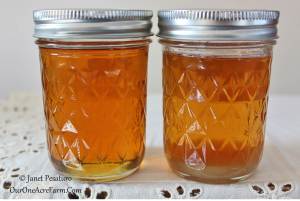
We are fortunate to have several large sugar maples at the edge of our yard, and can produce about 2 gallons of syrup in a year.
Maple sugaring is a possibility of you have maple trees in your yard. Read how we tap our sugar maples and make syrup here. Syrup can also be made from the sap of at least 22 trees, as you can read here. The main advantage to sugar maple sap is its higher concentration of sugar. This means that less time and energy are needed to boil it down, but you can tap other trees if you have the time and fuel.
Eggs
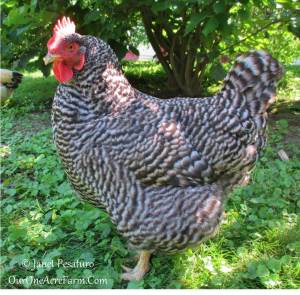
Chickens are becoming increasingly popular in suburban backyards. If you’re really tight on space, get bantam (miniature) hens.
Chickens are becoming increasingly common in suburban and even urban farms. For small backyards, consider keeping a few bantam (miniature) hens. Their eggs are just as tasty as large eggs. Read about the pros and cons of backyard chickens here. I’m often asked to recommend books on chicken care. I prefer the information-packed and time honored standards, such as Gail Damerow’s A Guide to Raising Chickens, and The Chicken Health Handbook. And Carol Ekarius’s book, Storey’s Illustrated Guide to Poultry Breeds, has beautiful photos and informative descriptions of many breeds of chicken and other poultry.
Quail are small and quiet, and are allowed in some towns and cities where chickens are not. The eggs are very small, but with supplemental light, they can produce as many eggs as chickens.
Meat
Rabbits, chickens, ducks, and quail can be raised on very small farms for meat, and small sheep can be raised for meat in a more generous sized backyard. Some livestock breeds can even be raised for dual purpose: poultry for both meat and eggs, and sheep for both fiber and lamb. So factor that in, when you select your breeds. But be sure you know what you are getting yourself into. Can you really kill, or send to slaughter, the animals you have cared for? If not, you can instead buy from a local farmer.
Fish
Aquaponics is a system of growing fish and vegetables together, so that the waste from the fish fertilizes the vegetables. The plants, in turn, clean the water, which is then recirculated back to the fish tank. Here is a remarkable example of a family that converted an old swimming pool into an aquaponic system where they raise fish, chickens, vegetables, and herbs. Now that’s an inspiration!
Foraging
If you have no land at all, you can learn to forage for wild edible nuts, seeds, berries, leaves, shoots, and roots. This is a wonderful way to develop an intimate relationship with with nature. There are many excellent books on foraging, but be sure you understand sustainable foraging practices before you begin.
Learning to forage can be a daunting task, for those who are not yet skilled in plant identification. My advice is get some books on plant identification, and learn to identify the plants growing in your own neighborhood. Then read up on them to find out if they’re edible. You’d be surprised how many of them are. It’s easiest to learn plant identification if you break them up into groups: trees, shrubs, herbaceous plants, etc. I started by learning tree identification, and began foraging their nuts and berries.
There are some excellent foraging blogs to consult, but for your own safety, I strongly urge you to get some respected books, and to attend programs of experienced foragers.
Preserving food
If you manage to produce, or forage for, a lot of any one food, you’ll want to learn how to preserve it. I don’t do a lot of preserving, because I prefer to grow small amounts of many different things. But I do dehydrate tomatoes and apples, and can applesauce and a few jellies and jams. Here are some great ways to preserve:
- Dehydration (my favorite, because the end product takes up much less space)
- Freezing
- Hot water bath canning
- Pressure canning
- Pickling
- Fermenting
Feel free to ask questions, and share your own tips and resources for small-space homesteading, in a comment!
Shared on: Simply Natural Saturdays, Homestead Barn Hop, Thanks Goodness it’s Monday, Tuesdays with a Twist, Homestead Barn Hop










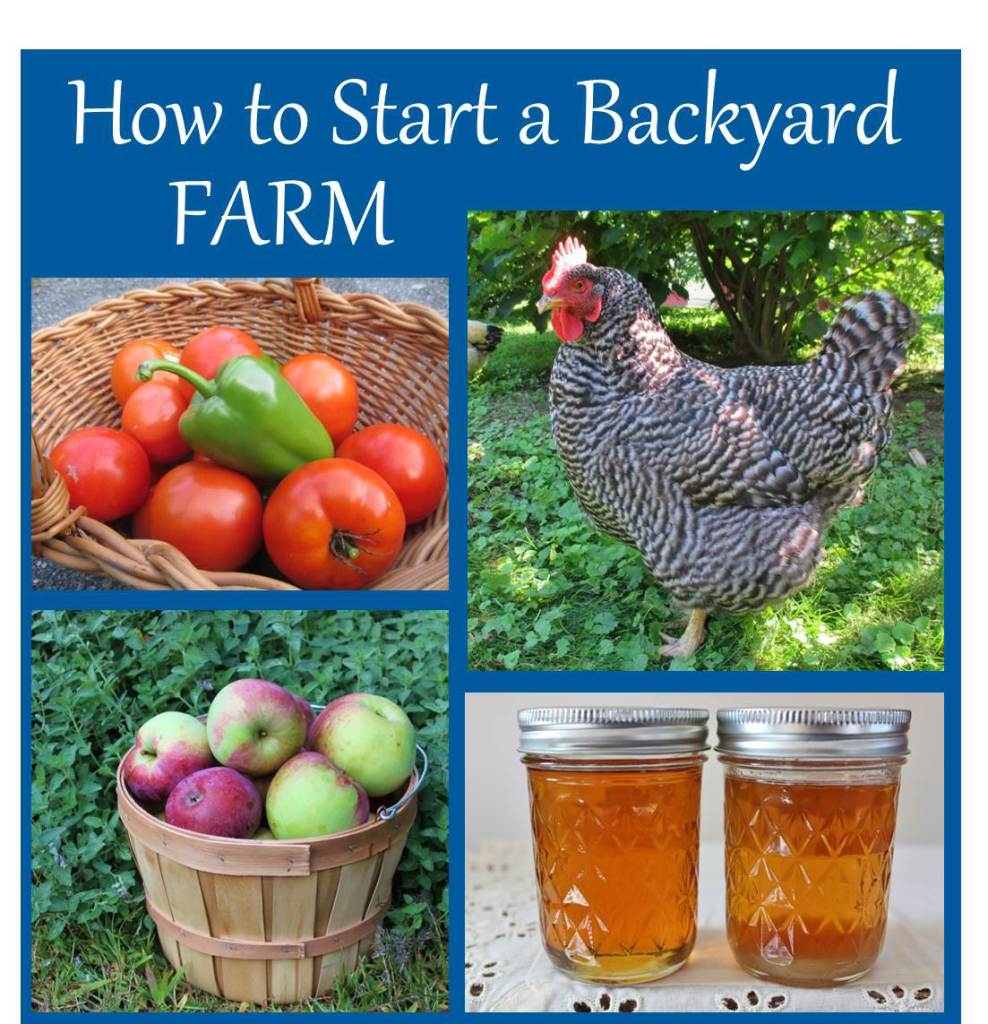
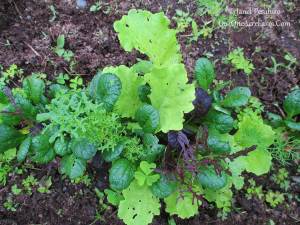
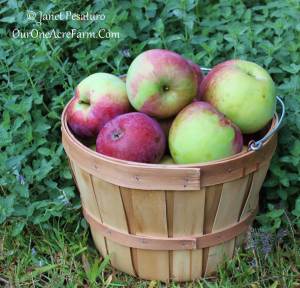
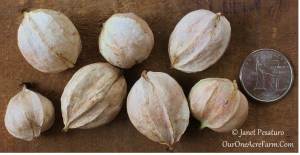
My small yard is going to be changed over next year from ground level gardening, to taller beds since my back has started causing me problems. I am trying to plan out the best layout. WE’d love to have you share your blog and any posts you like over at Country Fair Blog Party, which is a once a month link up.
www (d0t) thetipgarden (dot) com/2014/12/country-fair-blog-hop-december-14.html
Jan @ Tip Garden
Taller beds are a smart choice if you have back trouble. We are gradually converting all our beds to raised beds, because my back can’t take it anymore. Thanks for the invite to the blog hop – I’ll check it out!
I love this list! We’re still on a postage size suburban lot and a whole acre sounds like a dream to me right now 😉 but I definitely think I can find a few more things to fit in our space. We’re getting a few chickens in the spring but I’m really thinking that fiber bunnies might be a good one as well.
Good luck, Nicole! One acre still seems luxurious to us, too. We can do as much as we need to do on this little plot. Thanks for stopping by!
This is a great list of tips. When we purchased our little farm so many told us we couldn’t do anything with 4 acres. With the right planning we proved many wrong. We have had so much fun with our small acreage and learned a lot. We’re now preparing to sell so we can move further out and increase our numbers. Excited!
-Carole
This is a great list of tips. When we purchased our little farm so many told us we couldn’t do anything with 4 acres. With the right planning we proved many wrong. We have had so much fun with our small acreage and learned a lot. We’re now preparing to sell so we can move further out and increase our numbers. Excited! Thanks for sharing on tuesday’s with a twist
-Carole
Wow, 4 acres would be really lavish for us! I think I’d add a flock of Shetland sheep with that much space…and a green house. Good luck with your move!
You can add a greenhouse, I have my growing space in the back corner of our .29 of an acre property and added a 10×12 greenhouse last spring! By far the best addition you can make. I even grew out chicks in it this spring.
You’re right, I should do it. I think about it every year, but never get around to it. Would be great though, to extend the season in our cold climate.
I’m the founder/moderator for Punk Domestics (www.punkdomestics.com), a community site for those of use obsessed with, er, interested in DIY food. It’s sort of like Tastespotting, but specific to the niche. I’d love for you to submit this to the site. Good stuff!
Thanks so much for reaching out, Sean! I just submitted this post. It’s great to have found your site – I look forward to perusing it. I’ll be submitting more of my posts, now that I know about you. Thanks again!
Great post! Found you through Pinterest. I was wondering – what type of apple trees do you have and if you don’t mind me asking, where did you get them? We are huge into apples and live in northern Illinois, where many of the orchards use pesticides to keep their crop from dying during our shortened growing season. I would love to plant our own little trees for applesauce and pie filling! Thank you so much for sharing your info!
Hi Jen, I’m happy to tell you about our apple trees. We bought 2-3 ft tall trees from Miller Nurseries in NY. They are all semi-dwarf and highly disease resistant: MacFree (derived from McIntosh), Liberty, and Jonafree (derived from Jonathan). Miller was bought by Stark Bros. I was just on their website, and noticed Stark Bros. has those same 3 trees, plus an additional semi-dwarf, highly disease resistant variety called Freedom.
These trees have worked out beautifully for us. We use no pest controls other than planting for biodiversity. Annual winter pruning is the only care we provide (and protecting trunks from rabbits with hardware cloth), and we get abundant yields every other year. We get a moderate yield on the alternate years. The apples are not perfect looking “dessert quality” apples that you can buy in the grocery store, but many are good enough to eat out of hand, and paring knife helps with the others. They are far better than the small worm infested fruits you find on abandoned apple trees.
Awesome!! Thank you so much for the info!!
My biggest problem is keeping deer out of the garden. Our lot, house and all is a half acre. A good sized portion is wooded but provides great privacy so our garden space is small. With such a small space I don’t want to put up an 8ft fence. It would make the yard feel even smaller. Any suggestions?
Sara, I don’t have this problem, and don’t have any suggestions other than the well known ones: a dog, predator urine (can be bought online), human hair, etc. All sorts of deterrents are suggested (google, and you will find many), but none of these are 100% effective.
Thank you anyhow :). I’ll stick with those.
There’s a book “Deer Proofing Your Yard & Garden” by Rhonda Massingham Hart. It has great tips, but there is no 100% effective way other than putting up 8 ft.fence
Thank you. I don’t expect to be able to deer-proof it but I appreciate any suggestions. We live in town and I wouldn’t have expected such a problem. Last year I didn’t get a single tomato. City deer are smart lol. I’ll look up the book. Thanks again!
Hi Sara, we gardened for five years in an urban area thick with deer. My husband and adult son would urinate around the perimeter of the property in the evening (we were fortunate that they could do this in places where the neighbors couldn’t see them) and that seemed to help a lot.
Liquid fence makes a deer and rabbit repellent, it’s organic and smells pretty bad when applied but the smell fades quickly and it’s very effective.
A farmer I purchased blackberry and raspberry bushes from swore by a few drops of Tabasco in a spray bottle of water. Just shake it up and spray around the perimeter of the garden area, then also on the fruit/leaves themselves as the Tabasco is so dilute it won’t leave a taste–but it keeps the deer away!
Thank you so much for this site. I have just found you through pinterest and am quickly reading everything you have put out thus far. I am still in the planning stage, but it is so nice to see that my dreams are attainable. I have a couple small questions. What has been your experience with Shetland sheep? I have been planning to raise some satin angoras for fiber, but recently learned that a family member has allergies. My fear is that the sheep would be too difficult for me to handle, I am a 5’4″ woman and my husband would be of limited help. Also, I have been thinking recently about integrating a watercress bed into an aquaponics system, down the road, and was wondering if you have had any experience with such a thing.
Hi Kelly, I have no experience with watercress. I don’t have Shetland sheep either, but I read a lot about them because at one point I was considering them, plus a friend and neighbor raises them, so I am familiar. They are quite small and I don’t think your size would be a problem. My friend’s daughter, while a teenager, has done much of the work in raising them and showing them. Behaviorally, they are smarter and more dog-like (you can put them on a leash and walk them). They were derived from feral sheep on the Shetland Islands, so they have retained more smarts and ability to survive than highly bred sheep. They come in many colors ranging from black to browns to grays and white. Fleece is not nearly as soft as fine Merino, but I like the feel, and love the springiness. It’s one of my favorite yarns to knit with. Hope this helps – Glad you are enjoying my blog!
Pingback: How to Start a Backyard Farm - Lil Moo Creations
Pingback: How To Start A Backyard Farm | Homestead & Survival
I hadn’t thought of shetland sheep. Are they good for milking? About how big to they get? We’ve been thinking of rabbits. Are angoras a good multi-purpose rabbit, or are they mainly kept for their hair?
Our friends raise Shetland Sheep. The fleece is wonderful for hand spinning and knitting and the lambs are good for meat. You could milk them if you want, but it might be difficult because the teats are very small. For a backyard farm, though, why not. It can’t be more difficult than milking Nigerian dwarf goats. It says in wikipedia that rams can reach 125 lbs and ewes 100 lbs, but there must be smaller strains, or something, because our friend’s sheep look half that size. You can see some photos of her sheep standing next to her in her blog here: Wildairshetlands (dot) blogspot (dot) com/
Angora rabbits are mainly kept for the fleece, but there’s no reason you couldn’t use the culls for meat. To raise these rabbits, though, I think your main interest should be the fleece, which requires frequent maintenance to keep them from becoming a matted up mess.
Pingback: How to Start a Backyard Farm: There are so many options for small space homesteading! This covers space saving gardening, small livestock, foraging, and more. - Home Decor Coco
Pingback: What To Raise On Your Homestead or Backyard Farm - One Acre Farm
Pingback: 8 Reasons to Grow Daylilies - One Acre Farm
I was born and raised on our home farm. alot of those days have gone buy the wayside.Now there seems to be more interest in raising things at home be it fresh garden things or maybe some animals.If there is something I can do that might get someone interested in trying small farming.Enjoyed your articles look forward to reading more.Thank You
Thanks for stopping by, Tom. Good luck in getting others interested in small scale farming.
I love all your tips! We live in town now and want to get to a farm so bad. But for now we’re managing. I am really trying to be more self efficient and am seriously considering quail even though my husband says no way! He says I need to wait until we actually get actually farm for them.
Hi Cheyenne, thanks for stopping by, and good luck in getting some land and starting a farm!
Pingback: How To Start A Backyard Farm | GARDENING BUZZ
Pingback: How to Start a Backyard Farm: There are so many options for small space homestea… | Iconic Form
Pingback: 7 Ways to Start a Homestead (Without Being Overwhelmed) | Tenth Acre Farm
I love the honest hardworking way of life. Its a wonder why most tradition and knowledge has been relocated from minds of individuals to the internet as the best resource for homesteading and farming, thanks for sharing and helping to change minds of people when it comes to capitalism vs socialism.
Pingback: How To Start A Backyard Farm | Revirals
Pingback: Unique Home Improvement Projects You Never Knew You Wanted Until Now | Canvas Pretty
Pingback: 7 Ways To Start A Homestead Without Being Overwhelmed | Self Reliance Revolution
nice..
I recently bought a 6 acre land in Fiji and I am interested in backyard farming especially vegatables, chicken and ducks.
I have not done anything of this kind before and f you could assist in planning this project.
Do you know if I’m Michigan I can do this in my backyard? Is there anything that says I can’t raise a backyard garden have a greenhouse and chickens?
Pingback: Small Farm, Home Farm: Tips on Starting your own Backyard Farm - Verde Community Farm & Market
Pingback: The Complete Guide To Getting Started With Homesteading In 2018
Thanks for sharing your post. Is backyard farm homesteading is a good option to earn money? I have 4 acres land in my backyard house, Please give your advice what homestead business I can start in my backyard house. How much cost to start this business.
I live in a small town in Mississippi, we have like 1/4 acre. A few months ago my husband bought me a broken down garden tiller and took it to a small engine repair shop to get it fixed. That’s where we’ve started!!! He travels for work, he is gone 12 days and Home 9. These 9 days Home he’s building me a shelter for 2 little Nigerian Dwarfs, and picking up my tiller to get my garden started. Our back yard has a 6 ft privacy fence also. I’m so excited to get started on this adventure!!! I grew up on a farm and I’ve told my husband “I’ve gotta have animals to take care of and dirt to dig in”. His next trip home he’s building me a chicken coop!!!! Everything is being built from pallets that his son in law gets free from work. I’m super excited!!! I so loved your list!!! I’ve put so much time into research for this!!!
I love to read your articles. Here is the great info for starting backyard farm. Thanks and keep sharing.
We have about half an acre at our disposal to start backyard farming in Basking Ridge, NJ. Can I get help, who could come and set up a nice but manageable farm, which is easier to maintain? Any help in Basking Ridge, NJ will be appreciated
Pingback: 5 Recreational Hobbies You and Your Family Can Start in Your Backyard - Chris Ryan
In my opinion, at the farm should be goats and hens then you will always have fresh milk, meat and eggs for your family.